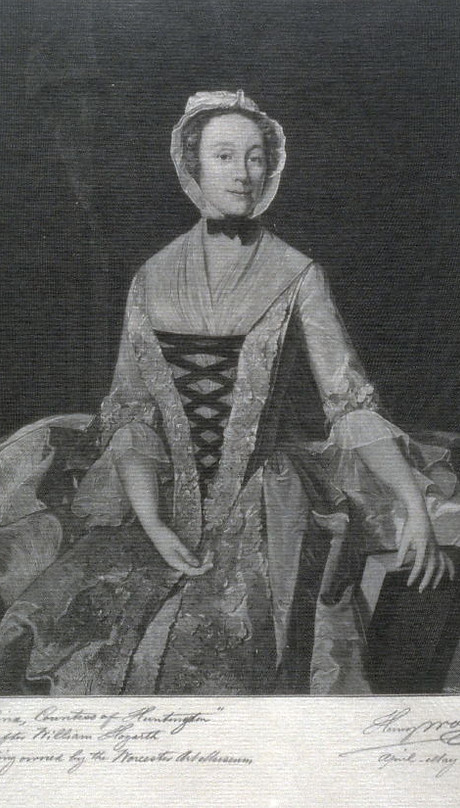HISTORY OF EMMANUEL
Emmanuel Anglican Church is both a new and an old Church in Tunbridge Wells. We have been moved to revive the work and vision of Selina, the Countess of Huntington. She established an Anglican Church for Tunbridge Wells in the 18th century. After some open air meetings in Tunbridge Wells, a church began meeting in her home, then moved to borrow an Independent Church building before erecting a new building in 1769. The church was called Emmanuel Church. George Whitefield was the first preacher at it. The services were similar to a Church of England church, but with the preaching modeled on the Bible teaching that energised the greatest religious movement England had seen – the 18th century revival.

Selina the Countess of Huntington
Many today have little experience of church. Many today feel the strain of trying to live life without knowing God in a deep meaningful way. Our times are similar to the 18th century. Then, as today, ministers such as John Wesley and George Whitefield laboured outside the structures of the Church of England. They preached about Jesus in ways that led thousands to turn to God.
A wealthy and strategic woman, Selina the Countess of Huntington, financed building churches. She longed to uphold and promote all that was good in Anglicanism, including the 39 Articles, liturgy and episcopacy.
Selina was concerned for Tunbridge Wells. She wrote, ‘I have waited on the Lord and I did not visit Tunbridge Wells till I was confidently assured that he had called me there. The fields are white for harvest. May the precious name of him who died be made very dear to many in this place.’

The work in Tunbridge Wells developed in an entrepreneurial, faith-filled way. The Church of England refused to allow evangelists to use their buildings, so Selina arranged for Charles Wesley and others to preach in an Independent Church building. She then organised open air preaching – the first such event in Tunbridge Wells featured as the preachers none other than Rev’d Martin Madan and Rev’d Henry Venn. J.C. Ryle called Venn one of the ‘spiritual heroes’ of his century. Ryle wrote, ‘The effects produced by Henry Venn’s preaching appear to have been singularly deep, powerful, and permanent.’
Selina recorded that when Madan and Venn preached to the crowds 'The Word came with power and the arrows of conviction struck the hearts of many.'
.jpg)
Rev. Henry Venn

First Building on Mount Ephraim
Sensing that God wanted to do a spiritual work in Tunbridge Wells, Selina purchased a house on Mt. Ephraim. From this base she hosted preachers such as George Whitefield and arranged for them to preach in the open air of the town. Reflecting on one such occasion, Selina wrote, ‘Truly God was in the midst of us. This leads me to hope God will smile on my humble efforts for the glory of his great name and the good of his people in Tunbridge Wells, and ultimately crown them with distinguished success.’
Emmanuel Church to 1974
The Countess built a church called ‘Emmanuel Church’ near her Tunbridge Wells home in 1769. The opening service was led by George Whitefield. So many people crowded to hear him that the preaching had to continue with the most famous clergyman of his century standing on a tree stump outside.
As the Church of England continued over the years to drift from the teachings enshrined in its formularies, groups of clergy left to serve alongside ministers in churches that had been established by Selina. Some were prosecuted for doing so – many gave up financial security and prestigious positions for their convictions. The evangelical passion of Whitefield, the financial and organisational genius of Selina, the pastoral experiences of former Church of England Ministers – they all helped one another.






In Tunbridge Wells, Emmanuel Church occupied a prominent position on Mount Ephraim for more than 200 years. Many older residents in the town remember the building fondly. Sadly, Emmanuel Church in Tunbridge Wells was demolished in 1974 to provide better access to a hospital - and of course the hospital itself has since been demolished as well.
At the time, the Civic Society called it an act of ‘cultural vandalism’ and a memorial stone was erected on the place where the church once stood. This is all remains physically of the original building. But in our church, the Spiritual work and vision continues today.
The history of Emmanuel Church in Tunbridge Wells is a story of entrepreneurial faith and outreach. Come visit us to discover how ‘Emmanuel Anglican Church’ is reviving the exciting vision of Selina, Venn and Whitefield.

Since 1974 until 2017, Tunbridge Wells had a season with no Anglican Church independent of the Church of England.
However, in 2017 Emmanuel Anglican Church relaunched the vision of Selina, Countess of Huntingdon, in reviving the historic Emmanuel Church and planting a new Anglican congregation in the town, separate from the Church of England. Initially Emmanuel Anglican Church was part of the Free Church of England.
Whilst the revived Emmanuel Church currently has no permanent building of our own, we take heart at the words of the apostle Peter, who reminds the church that we are 'living stones', being built by God to be His Church.
'As you come to him, the living Stone—rejected by humans but chosen by God and precious to him— you also, like living stones, are being built into a spiritual house to be a holy priesthood, offering spiritual sacrifices acceptable to God through Jesus Christ.' (1 Peter 2 v 2-4).
Today Emmanuel Anglican Church meets 1 mile to the southwest of where the original Emmanuel Anglican Church once stood. We meet at the Number One Community Centre on the Showfield's Estate at 10.30am & 6.30pm.
Come and worship with us this Sunday!

